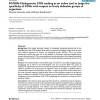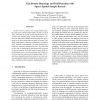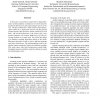342 search results - page 38 / 69 » A New Alignment-Independent Algorithm for Clustering Protein... |
BMCBI
2004
13 years 7 months ago
2004
Background: The rapidly increasing number of completely sequenced genomes led to the establishment of the COG-database which, based on sequence homologies, assigns similar protein...
BIB
2008
13 years 7 months ago
2008
The accuracy and scalability of multiple sequence alignment (MSA) of DNAs and proteins have long been and are still important issues in bioinformatics. To rapidly construct a reas...
ICPR
2008
IEEE
14 years 8 months ago
2008
IEEE
In this work we present a new string similarity feature, the sparse spatial sample (SSS). An SSS is a set of short substrings at specific spatial displacements contained in the or...
IPPS
2002
IEEE
14 years 15 days ago
2002
IEEE
In this paper we present new approaches to high performance protein database scanning on two novel massively parallel architectures to gain supercomputer power at low cost. The ï¬...
JCSS
2007
13 years 7 months ago
2007
Hidden Markov models (HMMs) are often used for biological sequence annotation. Each sequence feature is represented by a collection of states with the same label. In annotating a ...



